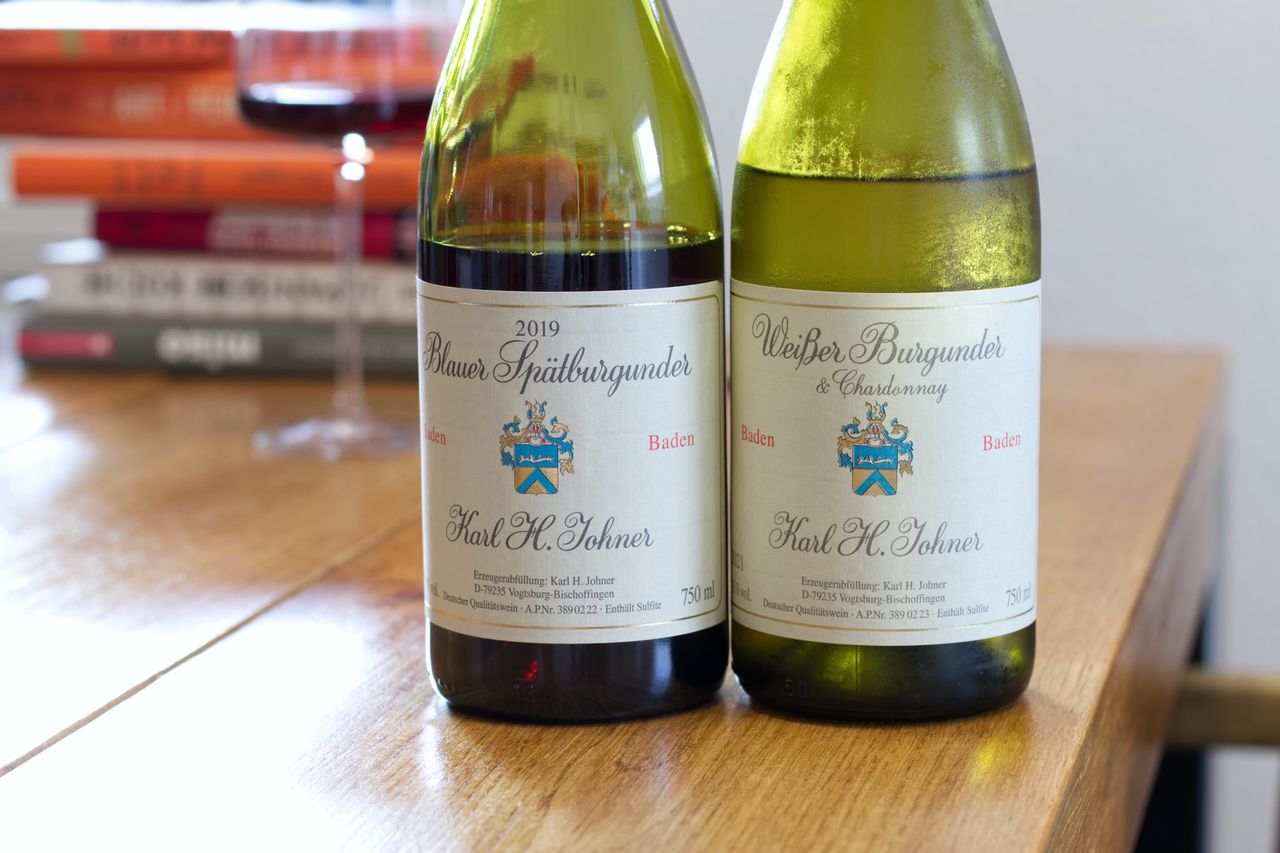Two Bottles Johner
We drink a bottle of Weisser Burgunder and Chardonnay 2021 and a blue Pinot Noir from 2019 from the Johner winery in Baden.

These two bottles are classic impulse buys. The box wasn’t full yet, and I wanted to order a mix from Baden. Somewhere in the back of my mind, I had heard of Johner before, so these two became my choice. I often do this because a full box of 6 or 12 just makes more sense when shipping. Besides, it’s the easiest way to try something new, apart from attending events and tastings. I’m still undecided on whether I find the labels so classic that they’re charming in their own way, or not. Nonetheless, the shopping cart clipart leading to the order form on the website just needs a flashing text for a time machine back to the internet of the 2000s. Somehow, I like that, and I don’t want to complain anyway. The detailed vintage reports with many pictures are quite cool, and for those who prefer not to read, videos are produced on YouTube, sometimes even during the harvest. I have respect for that. Karl Heinz Johner founded the winery in 1985 in Bischoffingen am Kaiserstuhl with his wife. And only now, as I write, do I realize that after Landerer and Höfflin, this is the third time Kaiserstuhl has come up in a short time. Meanwhile, son Patrick has joined the winery, and there is also a branch in New Zealand. However, our wines today come from Baden. The 2021 blend of Pinot Blanc and Chardonnay grows on loess and volcanic weathering soil. About two-thirds Pinot Blanc and one-third Chardonnay are mostly aged in stainless steel, with a small proportion aged in used wooden barrels. The 2019 blue Pinot Noir grows on similar soils. It ferments on the skins for four weeks and then matures for a year in used and new wooden barrels. All Johner wines are bottled under screw caps.
The white wine starts with a pronounced aroma of stone fruit. Yellow apples and pears, with a hint of spice and structure behind. Fresh and creamy in the mouth with pineapple notes. While it’s good, it doesn’t emotionally captivate me on the first evening. I don’t mind that anymore. I just put the bottle back in the fridge, and tomorrow is a new day. And that works for this wine too. Whether it was my mood on the first night or the fact that the wine might simply be too young, I don’t know. After a night in the bottle, it becomes noticeably creamier on the nose with much more richness. The stone fruit is still there, but there’s now more structure when drinking, making it much more interesting. The better half mentions Piña Colada because a subtle touch of coconut has joined the light pineapple. It has become more complex and interesting and this development continues throughout the evening. I would recommend forgetting the wine in the cellar for at least another year. Because a small amount on the third evening has become even better.
The blue Pinot Noir doesn’t need as much time to shine. It’s fruity and spicy on the nose with lots of berries, some cherry, and wood. Juicy on the palate, with red berry fruit and relatively low tannins. It’s dense and intense, but then, way in the back, it develops a gummy fruit note that somehow bothers me. Maybe there is more similarity to the white wine in its development than initially thought because, here too, I like the wine much better on the second evening. The Pinot Noir becomes earthier and slightly balsamic on the nose. There’s forest floor between the fruit, and if we’re comparing with cocktails already, it feels like a good Amaro. I really like the wine right now.
It’s interesting that both wines took a day to truly please. Both were good on the first evening, but not where they were at least a day later. But, as I said, it may also depend on the taster. And maybe adding a lot of oxygen by decanting could have possibly accelerated the desired development on the first evening. Since we rarely rush when it comes to wine, that doesn’t matter much to us. Another thing both wines have in common is how well each of them paired with sous-vide pork belly and potatoes.